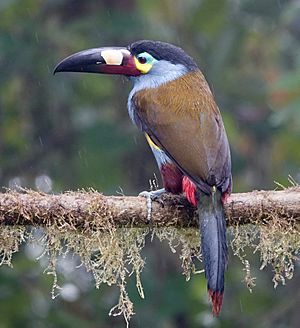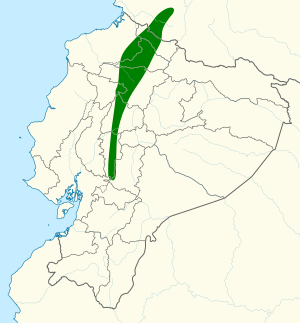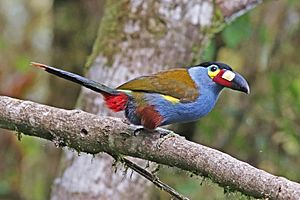Plate-billed mountain toucan facts for kids
Quick facts for kids Plate-billed mountain toucan |
|
|---|---|
 |
|
| In northwestern Ecuador | |
| Conservation status | |
| Scientific classification | |
| Genus: |
Andigena
|
| Species: |
laminirostris
|
 |
|
| Synonyms | |
|
|
The plate-billed mountain toucan (Andigena laminirostris) is a colorful bird that lives in the high mountains of Ecuador and southern Colombia. It belongs to the Ramphastidae family, which includes all toucans. This bird is known for its unique bill, which has a special "plate" on it.
Other names for this toucan include the laminated hill-toucan and laminated mountain-toucan.
Contents
What Does the Plate-Billed Mountain Toucan Look Like?
Plate-billed mountain toucans are medium-sized birds, about 42 to 53 centimeters (16.5 to 21 inches) long. They have a relatively light bill that can be up to 10 centimeters long. The average male weighs about 314 grams (11.1 ounces). Females are a bit lighter, around 303 grams (10.7 ounces).
Their large bill is flat on the sides. The front part is black, and the back part is mostly red. It has a raised yellow plate on the upper part, which is why it's called "plate-billed." This is a special feature unique to this bird.
Their eyes are reddish-brown. The skin around their eyes is bare and yellow below, turning turquoise green above. The top of their head and back of their neck are black. The rest of their upper body is a bronzy olive color.
The sides of their neck and their belly are blue-gray. They have a yellow patch on their sides, partly hidden by their wings. Their lower back is yellow, and their tail is black with chestnut tips. The area around their bottom (called the crissum) is bright red. Their upper legs are brownish-maroon.
These toucans have special feet called zygodactylous feet. This means two toes point forward and two point backward. This helps them grip branches very well.
How Do Plate-Billed Mountain Toucans Communicate?
This toucan is the most vocal of all mountain toucans. Males and females often sing together in duets. The male makes a loud, repeating "tryyyyyyyk" sound. The female makes a drier "t't't't't't't't" noise. They also make rattles and clicks that can be heard from over a kilometer away.
Where Do Plate-Billed Mountain Toucans Live?
Plate-billed mountain toucans live in the western foothills of the Andes Mountains. You can find them in western Ecuador and the very southwestern part of Colombia. In Colombia, they are found from Pita Canyon in Narino south to the northwestern border of Morona-Santiago Province in Ecuador.
These birds live in humid mountain forests. These forests are often misty and wet. They are found at altitudes between 1600 and 2600 meters (about 5,250 to 8,530 feet) above sea level. They have even been seen at 3100 meters (over 10,000 feet) in Imbabura, Ecuador.
The humid forests where they live have many epiphytes (plants that grow on other plants), bromeliads, and mosses. These forests get a lot of rain, about 14 feet per year. The tops of the trees (the canopy) are usually 6 to 10 meters (20 to 33 feet) high. Because they live at these high altitudes, they share their home with other birds like the Andean cock-of-the-rock. Their estimated living area is about 14,300 square kilometers.
Plate-Billed Mountain Toucan Life Cycle and Behavior
Reproduction and Nesting
The breeding season for these toucans runs from March to October. It is busiest from May through August. They build their nests in holes inside trees. These nests can be as high as 30 meters (about 100 feet) above the ground.
A female toucan usually lays 2 or 3 white eggs. The parents take turns sitting on the eggs for about 16 days until they hatch. The young birds stay in the nest for 46 to 60 days. This is when they grow feathers and learn to fly (fledge). After the young birds leave the nest, the parents might have a second set of babies.
What Do Plate-Billed Mountain Toucans Eat?
Plate-billed mountain toucans mainly eat fruit. They also sometimes eat insects and eggs. When they eat fruit, they help spread the seeds of plants. This includes seeds from shrubs like Faramea affinis and palm trees like Prestoea acuminata. There has even been a report of one eating a caecilian, which is a type of legless amphibian.
What is the Toucan's Conservation Status?
The Plate-billed mountain toucan is still a fairly common species. However, it is considered "Near Threatened" by the IUCN. This means it could become endangered in the future. Its numbers are going down because its habitat is being lost. This is mainly due to deforestation, which is when forests are cut down.
These toucans are also sometimes caught illegally for the exotic bird trade. The plate-billed mountain toucan is the flagship bird of the La Planada Nature Reserve in Colombia. This means it is a very important symbol for conservation efforts in that area.
See also
 In Spanish: Tucán andino para niños
In Spanish: Tucán andino para niños



